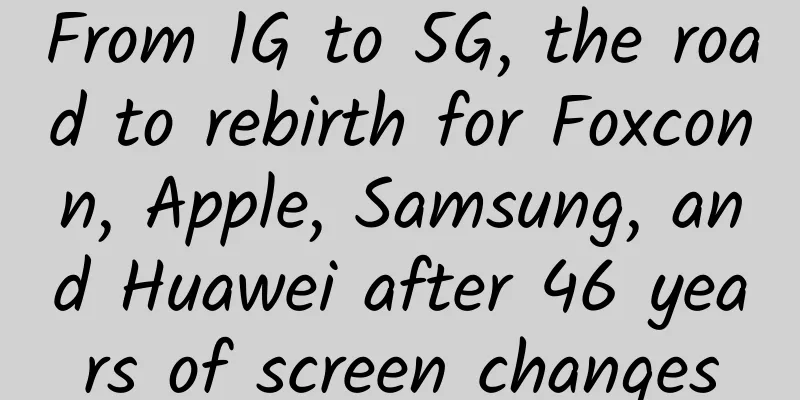From 1G to 5G, the road to rebirth for Foxconn, Apple, Samsung, and Huawei after 46 years of screen changes

|
Samsung took the lead, followed by Huawei, and foldable screens became popular in the early spring of 2019. However, the reform of this generation of screens has been bloody from the beginning. But in fact, the "battle" over mobile phone screens started much earlier than imagined.
Mobile phone screens and mobile communication technology are born together If we count from the launch of the first mobile phone, this "battle" even preceded the emergence of mobile communication technology and has lasted for 46 years. In 1973, the prototype of the mobile phone DynaTAC released by Motorola had a very small red monochrome LCD screen, which was only about 5cmx1cm in size and could only display 7 digits at most.
But at that time, the role of screens in mobile phones was far less important than the progress of mobile communication technology. Due to the limitations of communication technology in transmitting data, it was not until 20 years later, when 2G became slightly popular, that the display content of mobile phone screens was extended to pictures, text, signals, battery level, time, etc. As mobile phone users have higher and higher requirements for obtaining information, the original situation of "using communication technology to promote the development of mobile phone functions" has undergone a "reverse" change. BlackBerry cannot be ignored in this process. From the beginning, BlackBerry positioned itself as a "wireless handheld email solution terminal equipment provider", but the 2G network was not enough to support this idea. At a similar time, Siemens launched the color display phone S10, and Sharp released the J-SH04 with a built-in camera. In the era of color screens for mobile phones, the demand for color image transmission increased dramatically, and the development of mobile communication technology lagged behind the growth in demand, until Steve Jobs came out with the iPhone 4. The iPhone 4's screen combines LG's IPS wide-angle hard screen and Corning glass, plus multi-touch technology and front camera design, and has multiple functions such as anti-press water mark, anti-scratch, multi-touch screen control and front camera. It greatly improves the screen's value, allowing mobile phones to move from functional products to entertainment products, and also accelerates the development of communication technology to a higher and faster level. It was from this time that the "battle" over screens really surfaced, and it was not just the mobile phone and screen manufacturers who were involved, even the OEMs rushed to get a piece of the pie. In the era of intelligence, mastering the screen has become the focus If 3G gives mobile phone users the opportunity to break away from simple data transmission, then compared to 4G, 3G is more like a springboard, just like a gorgeous firework that is fleeting. Taking China as an example, shortly after smartphones such as the iPhone 4 entered the market and 3G had not yet made a big splash, the Ministry of Industry and Information Technology issued 4G licenses to the three major operators at the end of 2013, and it spread at an extremely fast speed. With the support of 4G network, the transmission of pictures and videos is no longer a problem, and the market's requirements for screen content have expanded from rich to exquisite, original color, comprehensive and three-dimensional. Along with it, Samsung, Xiaomi, Huawei, OPPO, VIVO and other mobile phone brands that are now well-known and occupy most of the smartphone market share have also grown up. But in fact, domestic mobile phone brands have not yet mastered the control of the screen.
There was a saying in the mobile phone screen industry: "Look at Samsung for high-end screens, and there is a mix of mid- and low-end screens. Even worse are Tianma and BOE." Needless to say, Samsung started out as an electronic product manufacturer and has always been at the forefront of the industry in screen R&D and manufacturing. Statistics show that about 90% of the OLED screens on the market are produced by Samsung, and Xiaomi, OPPO, Huawei, etc. are all Samsung's customers.
In addition, Samsung is also the absolute leader in high-end screens, such as AMOLED screens. Therefore, Samsung brand electronic products basically use their own screens. So from the beginning, Samsung has been absolutely independent in terms of screens, and there is no need to worry too much.
Compared to Samsung, Apple has to be much more worried and cautious. In fact, from the beginning, Apple did not completely rely on "external aid". After getting the screen, it would not apply it immediately. Instead, when there was a need for product innovation, it would transform the screen through software and technology to make it have certain differences and technical barriers. For example, iPhone X optimized the software of Samsung's AMOLED screen, increased the screen resolution to 2436x1125, and the contrast ratio reached 1000000:1. It also supports HDR original color display, becoming a "super retina high-definition display".
However, as Samsung's technical barriers in high-end screens become higher and higher, prices are getting more and more expensive. Industry insiders have estimated that the cost of Apple ordering a screen from Samsung has reached $110. Whether from the perspective of "monopoly" or cost, Apple needs to make changes. Therefore, for the new iPhone released last year, Apple ordered screens from no less than three screen suppliers, including Samsung, LG, and Sharp. There are even rumors that BOE has become a candidate manufacturer for the 2020 new model, after all, the company's screens are currently used in MacBook and iPad product lines. With such a decentralized screen procurement channel, coupled with software and technology optimization, the pressure on the iPhone's screen will naturally be much less for the time being. Of course, Apple will not always rely on "external aid". At the beginning of last year, news broke that the company had formed a team and was actively developing and producing MicroLED screens, which are more promising than OLED. It can be imagined that the company is determined to take control of the screen.
Like Apple, Foxconn is also eager to break free from its shackles. As a global foundry, Foxconn has only accumulated the ability of "assembly line manufacturing" in the past 40 years, and has made limited achievements in technology research and innovation, and is particularly dependent on iPhone orders. If Apple reduces the order volume or even cancels the cooperation, it will be a painful loss for Foxconn. In addition, as Samsung, Xiaomi, Huawei and other mobile phone brands are increasingly taking market share, iPhone shipment orders are also declining year by year. Guo Taiming is getting more and more restless.
As a major supplier of iPhone OLED, the cost of each screen provided by Sharp can account for 23% of the entire device. But Sharp has no ability to contain Apple. Since 2012, Terry Gou has personally started to acquire Sharp. It was not until August 2016 that he finally acquired 66% of Sharp's shares at a price 10 times higher than the bidder, totaling US$3.8 billion. "Acquiring Sharp was my third entrepreneurial venture," Guo Taiming recalled. "Sharp has more than 20,000 designers and engineers. Foxconn must not only continue to build on their talents, but also develop them. This is also the main way to change Foxconn's status as the 'world's foundry'." Although the acquisition of Sharp has not brought about much change in Foxconn's foundation, the number of iPhone orders placed with Foxconn has indeed increased. More importantly, Foxconn already has the ability to produce screens and electronic products on its own, but the cost-effectiveness remains to be verified.
Compared with the above three manufacturers, domestic mobile phone brands have much less initiative and control over the screen. In terms of high-end phones, Xiaomi, Huawei, OPPO, etc. mostly cooperate with Samsung and Sony. For example, the OPPO Find X, which was very popular last year, uses a Samsung screen.
As for mid- and low-end phones, domestic mobile phone manufacturers are still hovering on low-end screens from LG, BOE, Lens Technology, etc. The most effort is put into the under-screen fingerprint recognition technology, rather than the screen itself. It will take some time to master the control of the screen. But this does not prevent domestic mobile phones from making some attempts first, such as folding screens. Folding screens focus on technological breakthroughs, but their practical value is still insufficient Along with the folding screen, 5G is also on the hot search. This seems to further prove that communication technology is accompanied by the reform of mobile phone screens. The legend about the folding screen has been spread in a small range when the concept of flexible screen was first introduced. To put it more intuitively, the folding screen is the Plus version of the flexible screen. In this regard, LG is an industry expert. However, unlike previous screen reforms, flexible screens not only disrupt the screen itself, but also multiple industries such as mobile phone space design, battery life, packaging technology, as well as UI interface and software adaptation. For example, Samsung's Galaxy Fold has made many changes in the folding hinge. According to Samsung officials, "The backbone of the Galaxy Fold team spent a lot of effort to develop a complex hinge system that can be hidden to ensure that there is no obvious crease when the phone is folded and unfolded."
This may not be intuitive enough. Let's take Huawei Mate X as an example. In terms of hinge design, Mate X is obviously not as well hidden as Galaxy Fold, and there is even an obvious crease in the middle. Some industry insiders pointed out that it is precisely because many domestic mobile phone manufacturers have no accumulation in hinge technology that they have been delaying the release of foldable phones. In addition to the hinge, foldable screen phones also need to consider the internal space issues during the use of the product, so the component installation design must be changed. Due to limited space and high battery life requirements, battery technology must also be upgraded. Of course, as the biggest highlight of foldable screen phones, ensuring the interface is free and seamless when folding and unfolding is also one of the headaches for manufacturers. However, judging from the two foldable phones released so far, manufacturers seem reluctant to show off too much. Huawei sealed its phone in a display cabinet, and Samsung simply did not show it at its press conference in China. This kind of operation of only showing but not touching is really annoying. In addition to the above two giants, Royole also released a foldable screen mobile phone earlier. According to official information, Royole's FlexPai uses its self-developed Zen Wing flexible screen 2nd generation product, which can guarantee 200,000 folds. As for Xiaomi, Lin Bin previously released a prototype demonstration video on Weibo, and even started a "war of words" with Royole. Rumor has it that this phone was launched in cooperation with Visionox, one of the few companies in the world that has the ability to mass-produce AMOLED. At present, let alone whether foldable screen phones meet market demand and whether the current design and technical methods can ensure barrier-free use by users, the price of nearly 20,000 yuan is not enough to achieve popularization. But who can assert that the emergence of new things must take time to grow, just as 5G is currently expected but not owned by everyone. After the foldable screen has become popular, the next step is for all manufacturers in the industry chain to work together to solve the problems of use and cost. |
<<: Patent exposed! Google is about to launch a foldable smartphone
>>: Another way to bypass the non-public API restrictions on Android P and above
Recommend
TIKTOK won’t install? It costs 10 yuan to install it once. This information gap is too profitable.
TIKTOK won’t install? It costs 10 yuan to install...
Testin Cloud Testing and Chukong Strategic Cooperation: Helping North American Developers Improve Game Quality
Testin, the world's largest real-device cloud...
Momo information flow advertising skills, play with pan-entertainment social information flow advertising!
Written in front Momo is a pan-entertainment soci...
What are the essential elements of high-quality creativity? On the importance of a high-quality creative idea in bidding promotion
What should we do if we encounter the above situa...
Google admits it is developing a foldable phone prototype, but the launch is still a long way off
According to CNET, at this year's I/O Develop...
Learn these 6 ways to play, and your Douyin account can also bring goods
As Douyin’s ability to sell goods continues to im...
Li Enlin, "The Innovation and Expansion of Songcheng Performing Arts' "One Play""
Li Enlin's "Songcheng Performing Arts: I...
Can't play Project Ara? Try a modular phone case
Project Ara's modular phone is mind-blowing. ...
Cook's Views on the Reformation
[[150408]] The Reformation movement, which began ...
E-commerce operations: 50 Taobao brand marketing notes
Taobao was born in 2003. The first batch of “Taob...
Sohu account, Baijia account, which platform is the most suitable for self-media people?
Self-media has become a common model for personal...
Download Douyin Live Streaming Crash Course Baidu Cloud
Download Douyin Live Streaming Crash Course Baidu...
Dubbo source code interpretation and practice, master the underlying source code of the framework, and improve practical development capabilities
Dubbo source code interpretation and practice, ma...
How does WeChat business promote and attract traffic? What are the effective WeChat business promotion and attracting methods?
Although Wechat business is not as popular as it ...
This kind of employee will either be a shareholder or a boss in the future!
1. Loyal people are not fired The company may fir...









